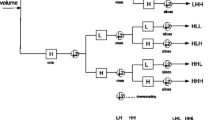Abstract
For the field of cognitive neuroscience and medical image analysis, feature fusion of multimodality from fMRI data is a significant yet challenging problem, and it usually requires brain data from different imaging methods which often leads to the result deviation caused by registration problems, and cannot make full use of data information. In addition, most of them emphasize on single scale spatial of brain, which omits lots of potentially available information, while human brain is multiscale in character. To solve these problems and obtain more useful information from single modality image, we introduced the method of graph signal wavelet transform. It could bond latent graph structure and signal constituted by the value in each vertex on graph, which possess the advantage of fusing activation (signal on graph) and connection information (graph structure) of brain. Besides, the property of multi-scale in wavelet transform could contribute to extracting multi-scale information of brain. Inspired with that, in this paper, we proposed a novel Graph Signal Wavelet Multi-Scale (GSWM) feature construction framework, for fusing multi-scale information extracted from both functional activation and underlying functional connection of brain, to retain more comprehensive information only using fMRI data. The results showed that the multi-scale features also catch the tendency of changes among different scales information, which reflects the cognitive process. In addition, with the multiple task fMRI data from the Human Connectome Project (HCP), the prediction capability of the GSWM features showed its overwhelming advantage in feature fusion and further brain states decoding.
Access this chapter
Tax calculation will be finalised at checkout
Purchases are for personal use only
Similar content being viewed by others
References
Sui, J., Tülay, A., Yu, Q., et al.: A review of multivariate methods for multimodal fusion of brain imaging data. J. Neurosci. Methods 204(1), 68–81 (2012)
Jie, B., Zhang, D., Cheng, B., et al.: Manifold regularized multitask feature learning for multimodality disease classification. Hum. Brain Mapp. 36(2), 489–507 (2015)
Huesman, R.H., Klein, G.J., Kimdon, J.A., et al.: Deformable registration of multimodal data including rigid structures. IEEE Trans. Nucl. Sci. 50(3), 389–392 (2003)
Betzel, R.F., Bassett, D.S.: Multi-scale brain networks. NeuroImage 160, 73–83 (2016)
Horikawa, T., Kamitani, Y.: Generic decoding of seen and imagined objects using hierarchical visual features. Nat. Commun. 8, 15037 (2017)
Hui, W., Chen, C., Hsieh, F., et al.: Extracting multiscale pattern information of fMRI based functional brain connectivity with application on classification of autism spectrum disorders. PLoS ONE 7(10), e45502 (2012)
Shuman, D.I., Narang, S.K., Frossard, P., et al.: The emerging field of signal processing on graphs: extending high-dimensional data analysis to networks and other irregular domains. IEEE Signal Process. Mag. 30(3), 83–98 (2013)
Goldsberry, L., Huang, W., Wymbs, N.F., et al.: Brain signal analytics from graph signal processing perspective. In: IEEE International Conference on Acoustics, pp. 851–855. IEEE. (2017)
Glasser, M.F., Sotiropoulos, S.N., Wilson, J.A., et al.: The minimal preprocessing pipelines for the human connectome project. NeuroImage 80, 105–124 (2013)
Hammond, D.K., Vandergheynst, P., Gribonval, R.: Wavelets on graphs via spectral graph theory. Appl. Comput. Harmon. Anal. 30(2), 129–150 (2009)
Author information
Authors and Affiliations
Corresponding author
Editor information
Editors and Affiliations
1 Electronic supplementary material
Below is the link to the electronic supplementary material.
Rights and permissions
Copyright information
© 2019 Springer Nature Switzerland AG
About this paper
Cite this paper
Xu, W., Li, Q., Zhu, Z., Wu, X. (2019). A Novel Graph Wavelet Model for Brain Multi-scale Activational-Connectional Feature Fusion. In: Shen, D., et al. Medical Image Computing and Computer Assisted Intervention – MICCAI 2019. MICCAI 2019. Lecture Notes in Computer Science(), vol 11766. Springer, Cham. https://doi.org/10.1007/978-3-030-32248-9_85
Download citation
DOI: https://doi.org/10.1007/978-3-030-32248-9_85
Published:
Publisher Name: Springer, Cham
Print ISBN: 978-3-030-32247-2
Online ISBN: 978-3-030-32248-9
eBook Packages: Computer ScienceComputer Science (R0)





